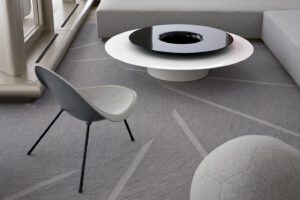56 LEONARD STREET – GALLERY & SALES OFFICE
Solution:
The facility is contained in a 2500 ground floor space in a cast iron loft building a block away from the construction site. The entry sequence is like a vest pocket park space replete with custom designed platforms and park benches. The prospective clients are greeted with a multimedia presentation of full height overhead projected montages of Herzog and De Meuronu2019s process in the design of what will be one of the most unique, rigorous and beautiful residential buildings to be constructed in New York. In determining how the space should look we tried to crawl into the psyche of the infamous team by visiting their offices in New York and Basel Switzerland to understand what made the building tick. The design had to reflect the psyche of the building.
The final layout for the gallery space does not represent any of the actual units in construction. It is an amalgam of the full scale features that many of the units will boast including its piano shaped kitchen island, full size concrete columns, custom bowed plaster wall that masks a vent hood and a wooden version of the full scale continuous metal and glass window. In some cases the window wall will be 14 feet highu2026so an effort was made to integrate all types of window treatment in it. Thus a double-layered cloud colored diaphanous cotton sheath is set within the upper horizontal member. The fabric curtain is like u201d Vaseline on the lensesu201d, a foil to the rigor of the metal and glass curtain wall itself. Beyond the exterior wall of the building is a white stretched backlit fabric that suggests light mood swings from Day to Night.
The buildings plan and section itself suggested how to organize the space and design its contents. The thrusting vectors of the plan and section are assimilated in the shutterbug -like form of the custom designed Vu2019Soske rug. The rug spins and moves from a center compass generated at the orthogonal pivot point from exterior to interior at the terrace corner. It is woven in concentric circular texture with rays of light spinning from its center adjacent to the concentric circular tables (prototype by Todd Bracher)
All materials used in the space relates to those of the building itself; whether concrete in color and texture, the raw stripped down natural wood, the sheen of anodized metal wall sections, or the pristine sharp edges of steel and glass. Both the Shiro Kuramata revolving red cabinet and the Noguchi black turning top chess table suggest the dynamic quality of the individualized units as they are stacked one on top of each other. A large-scale wool flannel faceted spherical angle soccer ball floats in the space and becomes a seat itself as it links the two seating groupings. Its shape as well as the sphere being held in the Marina Abramovic black and white photograph in the entry vestibule are visible simultaneously are oblique gestures to the buildings worldly international status. Art is hung throughout the space with Robert Mapplethorpeu2019s u201cRed Tulipu201d symbolizing that a living colorful organism will ultimately inhabit the pristine space.
The building is a work of art and this imagined unit should reflect that sensibility.











